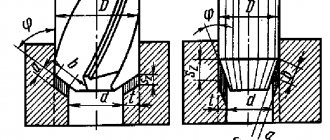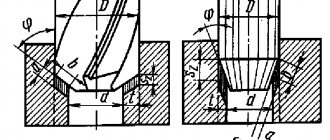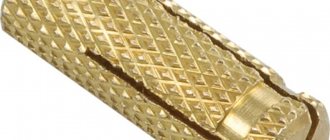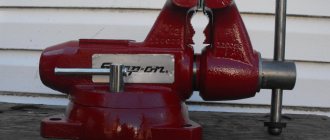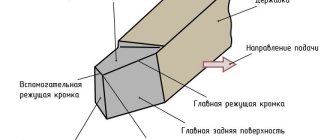When processing metal workpieces in workshops, garages and car repair shops, an electric drill with equipment is often used. If you need to remove a layer of metal, process irregularities or enlarge a hole, use a metal burr. It is considered indispensable when working with metal products. Before purchasing cutters, it is important to understand what they can be made of and how to use them.
Metal burr
Wood burrs (cutters) for engravers: types, purpose, features
Wood products, which in our time remain one of the most popular materials, are actively used for home improvement, as well as for decorative purposes. Previously, in order to make such products, one had to turn to qualified specialists, but now every home craftsman can perform many works on such material independently, using wood burrs and a regular electric drill or screwdriver.
A wood drill is used for milling technological and decorative elements
Burrs for performing decorative work on wood, which also have other names - “cone cutters”, “cone cutters”, are used not only by home craftsmen, but also by qualified specialists - carvers, for whom the manufacture of wood products is the main activity.
Arsenal of wood carver tools
The main tool for cutting wood, as mentioned above, is a burr. The implementation of such a procedure, during which a layer of the processed material of various depths is removed, is ensured by the rotation of the cutter, as well as its translational movement along the required trajectory. Accordingly, equipment is also required with which the tool used will be driven into rotation. Such equipment, indispensable for an engraver and any woodcarver, is a drill, often called a Dremel.
Dremel produces electric engravers for household and professional grades
The word “Dremel” comes from the name of the German company Dremel, which produces a large range of electrical equipment, in which drills and specialized engravers occupy a significant place. Drill kits from Dremel and other manufacturers already include everything you need to install the tool and get started.
You can also cut wood using cutters using a conventional electric drill or screwdriver, if you equip them with a flexible shaft and a special attachment on it, into which a burr is installed. This simple device is also suitable for an engraver who works with products made of metal and other materials.
Flexible shaft for drill
The quality and attractiveness of the work performed when cutting wood directly depends on the characteristics of the equipment used. Even the experience and knowledge of the person performing such work cannot positively affect the characteristics of the finished product in the absence of appropriate equipment and wood burrs.
Types of rollers by shape
Burrs are available with various shapes of cutting surfaces, since they are intended not only for linear processing, but also for profile cutting of grooves, ledges, recesses and edges. The main shapes of the heads of this tool are regulated by Russian GOST 3402-2017, which corresponds to international ISO standards and German DIN. Among them, the most common are cylindrical, spherical and conical (in various variations). The table below shows the basic shapes and letter codes of burrs for processing metal and soft materials, as well as the types of profiles for which they are intended.
In addition to the shape of the cutting head, the burr is characterized by geometric dimensions, length and diameter of the shank, as well as the type of cutting teeth, which also has a standardized designation (see the next section).
Types of burrs for woodworking
Metal is predominantly used as a material for the manufacture of burrs, which are used for both cutting wood and engraving on metal, plastic or stone. Tools made from carbon steel are suitable for processing softer materials. In order to cut products made from harder wood, it is necessary to use cutters coated with diamond or with a cutting part made of hard alloys.
Naturally, the most inexpensive are burrs made from carbon steel, but their service life is significantly shorter than that of diamond and carbide tools. Carbide cutters not only have an increased service life, but also allow you to effectively process hard wood, as well as the surface of metal products.
Geometric parameters of the burr
Any burr, regardless of its purpose, consists of two main elements:
- a shank with which the tool is fixed in the equipment used;
- the working part that performs the main work.
The working (or cutting) part of a wood burr can have a different configuration. It is the shape of the cutting part that determines the profile of the groove cut on the surface of the workpiece.
Wood carvers use burrs, the cutting part of which has a conical, oval, semicircular or round shape. In order to always have the required tool at hand, it is better to immediately purchase a set of cutters, which contains burrs of various sizes and with different shapes of the cutting part. At the same time, it is better to buy burrs from a trusted manufacturer: they will last much longer and will allow you to cut wood with higher quality.
Wood cutters are available in a variety of teeth, shanks and finishes.
A novice woodcarver should take safety precautions very seriously. Since wood cutting is performed with a burr rotating at high speed, pieces of cut material fly out of the processing area in all directions. In addition, there are often cases when during such processing not only the cutting teeth of the tool break, but also its entire working head. Such situations are typical for the use of low-quality burrs. In this regard, in order to protect yourself from injury, all procedures for processing wood products must be performed with protective glasses and gloves.
Areas of use
Roller cutters made from hard alloys are used in various industries:
- manufacturing of ships, cars, airplanes;
- printing;
- processing of high-strength alloys;
- jewelry making;
- electronics.
Using burrs, you can bore holes, create inscriptions on metal surfaces, make grooves, and grind parts where it is impossible to reach with a grinder or grinder. Metal drill accessories are used to repair various metal structures.
Carbide burrs
Carbide burrs are cutting tools used for removing welds, removing burrs, leveling surfaces, and finishing work on products made of plastic, wood and stone.
- Sort:
- Price
- Popularity
- View:
- Tabular
- Lowercase
Used on straight grinders with electric drive or pneumatic drive for processing the outer surfaces of profile parts (cutting edges, deburring and chamfering).
Used on straight grinders with electric drive or pneumatic drive for processing protruding parts of non-flat parts - grinding, processing joints, removing welded reinforcements.
Used on straight grinders with electric drive or pneumatic drive for processing surfaces inside complex profiles (processing radius grooves, forming internal radius mates).
Used on electric or pneumatic driven straight grinders to finish surfaces in narrow or hard to reach areas.
Used on straight grinders with an electric drive or a pneumatic drive for processing the internal surface of the “corner” type (cutting edges, removing burrs and chamfers, processing radius grooves, forming internal radius mates).
Used on straight grinders with electric drive or pneumatic drive for processing joints of cylindrical parts - grinding, processing joints, removing welded reinforcements.
Used on straight grinders with electric drive or pneumatic drive for processing the outer surfaces of profile parts (cutting edges, deburring and chamfering).
Used on straight grinders with electric drive or pneumatic drive for processing parabolic surfaces inside the profile - grinding, processing joints, removing welded reinforcements.
Used on straight grinders with an electric drive or a pneumatic drive for processing the internal surface of the “corner” type (cutting edges, removing burrs and chamfers, processing radius grooves, forming internal radius mates).
Used on straight grinders with electric drive or pneumatic drive for processing joints of cylindrical parts - grinding, processing joints, removing welded reinforcements.
Used on straight grinders with electric drive or pneumatic drive for processing remote (recessed) places in profile parts (cutting edges, deburring and chamfering, processing grooves).
Used on straight grinders with electric drive or pneumatic drive for countersinking and edge processing of cylindrical surfaces.
Burr manufacturing technology
The production of burrs is carried out in two stages.
- Making a shank for a burr.
The rod is cut.
- One end of it is threaded on a grinding and roughening machine.
- The rod is straightened on a straightening machine.
- The end is trimmed, centered and cut off.
- The second end is trimmed.
- The cone is machined and the chamfer is removed.
- A groove is milled on the cone.
- The workpiece is soldered to the shank.
Photo No. 3: making a burr
Features and purpose
The design of the burr is designed to perform the process of milling decorative elements. With its help, part of the wood layer of the required depth is removed. Despite many years of use, the devices are constantly being modernized in order to improve the quality and accuracy of processing. However, the very basis of the design has remained virtually unchanged. It still consists of two parts:
- shank for fastening standard sizes,
- cutting part.
The main feature of a burr is that it is not a power tool, but a dynamic one, which is why it is used with a tool that ensures its rotation.
In the arsenal of engravers and professional woodcarvers, a Dremel, a special drill, is used to ensure the translational movement of the head of the device along the desired path. In domestic conditions, a screwdriver or electric drill works perfectly with its functions.
A wood cutter can be used if necessary for:
- processing the edge part when combining several workpieces due to grooves.
- fittings of fittings to pieces of furniture,
- production of decorative elements of volumetric and complex configurations.
The attachments can be used in operations:
- drilling,
- polishing,
- grinding,
- tongue and groove,
- surface cleaning,
- creating grooves
- final processing of a hole or cavity.
Selection of burrs by marking
As we have already said, markings are applied to all burrs. We'll teach you how to read it. The marking consists of two letters and four numbers. These are the characteristics of a burr.
- The first letter is the type of burr based on the shape of the head.
- The first number is the diameter of the cutting part.
- The second number is the length of the head.
- The second letter is the type of notch.
- The third number is the diameter of the shank.
- The fourth number is the length of the shank.
Consider an example.
Image No. 15: burr markings
Classification
Wood burrs are rotating parts, the entire surface of which is covered with notches.
They come in different shapes:
- cylindrical,
- spiral,
- hyperbolic,
- oval,
- conical,
- spherical.
The most inexpensive products are made of steel. Their service life is shorter than equipment made from carbide materials, whose notched head is often seated on iron cores using brass solder.
Their high cutting performance coupled with good removal allows achieving results in the shortest possible time without clogging the tool. Thanks to the hard alloy, the products retain their properties for a long time when used even in the most difficult conditions. The processing is as smooth and clean as possible, and the chips are powdery.
The processing properties are influenced by the type of tooth cutting, which can be:
- thin,
- large,
- universal,
- ultra-thin.
Using a large-tooth burr allows you to quickly remove a layer of wood without much effort. Their surface is coated with a special multilayer composition, which increases wear resistance.
Manufacturers offer sets of attachments of different designs and prices:
- prefabricated,
- with replaceable edges,
- monolithic.
- terminal
- copying machines,
- edge
- grooved
A set of wood burrs for an engraver is selected depending on:
- quality of material for processing,
- type of work,
- number of revolutions of the rotation device,
- notch configurations.
The product head with a chipbreaker configuration processes material without sticking, producing maximum removal.
Control and test methods
Burrs, despite their apparent simplicity of design, are very precise, durable tools that experience enormous loads. Its quality should be at its best.
Since the burr market is overflowing with offers from a variety of manufacturers, often seeking to increase production volumes at the expense of quality, control over compliance with GOST is necessary.
Large enterprises that regularly use burrs usually purchase them from several trusted suppliers. And they are periodically compared with compliance samples.
The quality of the material, the strength of the soldering of the leg and the working head, precise alignment, ideal geometry, the ratio of the bakelite base and high-quality abrasive - all this matters for the operation of the burr.
There are several control methods:
- Visually, with a magnifying glass and caliper, check the appearance and roughness;
- Using a microscope and using laser centerers, it is checked whether the burr has any deviations in alignment;
- Durability is tested using electrical or pneumatic equipment. The total length of the test milling is 3000 mm if d burrs < 10 mm, and 10000 mm if d > 10 mm.
After the test work, there should be no chips or chips left on the burr and it should remain suitable for work.
A simple quality check of a carbide burr can be carried out at home.
Review abrasive uniformity and grit calibration using a magnifying glass. Is the connecting seam between the working part and the pin strong enough or is the soldering done poorly, with large gaps.
You can, by holding the burr in the drill chuck, turn on the tool at high speeds - the asymmetrical shape of the rotating cutter, noticeable even to the eye, will indicate incorrect alignment.
Do not work with low-quality or worn burrs! This may cause damage and injury.
Cutters for artistic wood carving
Thanks to carving and burning, real works of art are made from wood. A glance is enough to understand what the master wanted to express.
Artistic carving is an ornament, pattern or design on the surface of wood. The manual carving tool is designed for slots with a depth of 0.5 mm - 2 mm. Laser engraving products are essentially multifunctional 3D printers. The choice of burrs for carving wood depends on the type of operation. For grooves, it is better to use disk cutters; when making cuts of complex configurations, it is better to use shaped attachments.
Application of burrs
There are many areas of application for burrs. Among them:
- removing flash and specks from workpieces;
- grinding of surfaces, grooves and holes;
- processing of welds;
- performing various technological operations in hard-to-reach places;
- engraving;
- cutting complex shaped holes;
- etc.
Burrs are even used in the electronics industry, jewelry and printing.
Type of tool and material
The use of the type of burrs directly depends on the technological tasks.
With their help you can work not only on wood, plywood, chipboards, but also on other materials:
- metal,
- cast iron,
- plastic,
- bone,
- combined.
When choosing, you need to consider:
- type of work,
- properties of parts materials,
- dimensions of processed elements,
- scope of use.
Professional products include diamond sharpening products. They are excellent for machining very tough boring materials and fine grinding of deep holes.
Recommendations
- You cannot combine an inch collet with a millimeter shank, otherwise the tool will quickly break.
- It is necessary to ensure full contact of the equipment with the surface being processed.
- For better sliding of the head, use special lubricants.
- You cannot put too much pressure on the burr head, because it will overheat and work slower.
- Do not touch the tool shank to the surface of the part.
- It is important to maintain a high rotation speed to avoid unevenness.
Working section profiles
Standard sharpening. Has one long notch. Suitable for cast parts, welds, alloys, brass, steel, including resistant heat-treated steel. Allows you to make large allowances. The shavings are long. Efficiency is optimal.
Double sharpening. It has cross-shaped notches on the working surface, resulting in the formation of teeth. Universal type. Suitable for working with any materials. Reduces burr vibration, allowing for better control of the process. Provides high cutting speed. Leaves a clean, smooth surface. The teeth formed as a result of notching are straight and multi-directional. A burr with this sharpening produces small chips.
Large sharpening. It has one wide notch (width and angle may vary). Great for soft materials such as aluminum and where large volumes need to be removed. Fast work with large chips.
How to choose an engraver for manual work
Hand engraving on wood takes a lot of time and requires:
- a set of gravers - steel rods with ends of different shapes,
- punch for drawing dotted lines,
- lamps with lens,
- device for laying the workpiece,
- flat pad with sand.
Manual milling cutters are equipped with so-called finger designs. Thanks to scientific and technological progress, the modern market offers engravers modern types of wood carving tools that operate on electricity. Manufacturers position them as small format drills.
Beginners should pay attention to the main parameters:
- number of spindle revolutions,
- energy consumption level.
The image in the form of a line pattern is obtained after cutting through the wood to the required depth.
Electric tool sets are equipped with:
- ergonomic handle,
- collets,
- milling, corner attachments.
In 99% of cases, the equipment of a hand-held wood engraver consists of:
- classic cutters fixed with a collet or adapter,
- drills with ball-shaped tips,
- brushes for roughing workpieces and finishing,
- set of drills,
- cutting discs.
Engravers are equipped with ultra-thin cutters, which negatively affects the quality of processing of hard workpieces compared to manual milling cutters
What is laser engraving on wood?
Laser processing is considered the most labor-intensive engraving - this is an innovative way to remove a layer of material. It eliminates deformation because the object or part does not heat up.
But it should be borne in mind that different wood can be processed differently by laser. Laser engraving of wood differs from laser cutting, so precise focusing of the laser beam and the correct selection of optics are required. Experts do not recommend using this method when engraving small elements, and when cutting, take into account the thickness of the workpiece.
A laser, unlike a burr for an engraver, provides a unique opportunity to perform:
- deep relief engraving,
- wooden mosaic
- contactless processing without damaging the wood structure.
- high processing accuracy with minimal cutting width.
The difference between burrs for wood carving and metal cutters
Structurally, cutters for metal are similar to those used for woodworking. But metal processing is characterized by a greater load on the cutting tool, so the equipment is made from materials with a large margin of safety, smaller sharpening angles, and a special tooth configuration. In addition, technologies differ in cutting modes. When processing wood, the rotation speed of the cutter is higher than when processing even soft metal.
In addition, cutters become very hot during metal processing, so they are made of refractory alloys. Woodworking equipment cannot withstand high temperatures.
Video comparison
Exploitation
So, when starting work, it is important to remember the correct choice of standard size for the type of processing that is to be done - roughing, finishing, sphere, plane, etc.
For example, you should not use a spherical burr with a coarse cut to grind an internal sharp groove. To do this, it would be better to take a conical one with a double notch.
A carbide cylindrical burr with a double fine cut will make the plane ideal, while a spherical burr in this case can only ruin the workpiece. The harder the metal being processed, the smaller the cross-section of the burr should be - this is one of the basic principles of operation.
Failure to comply with this rule will lead to clogging of the grooves between the burr teeth, overheating of the tool, its rapid wear and poor quality work results.
The smaller the diameter of the burr, the higher the rotation speed should be. As the diameter of the tool increases, the number of revolutions per minute of the engine should decrease.
Use the maximum permissible speeds of the required modes. Otherwise, beating, chipping, and premature wear of the teeth are guaranteed.
When clamping the shank in a chuck or collet, a minimum area must be left free. This reduces vibration and minimizes the risk of shank breakage.
The force of pressure on the burr does not increase its efficiency, but increases the load on the tool and equipment. This may cause them to fail. Don't push!
It is necessary to remember the safety rules, protection of the organs of vision, hearing, and hands from possible damage. The eyes are the most vulnerable organ and to protect them you need to choose safety glasses wisely.
Special impact resistance markings on glasses will help you choose them correctly.
Existing designations for mechanical strength:
- S - high strength;
- F - for spent particles with a speed of 45 m/s;
- B - for spent particles with a speed of 120 m/s;
- A - for spent particles with a speed of 190 m/s.
In our case, when working with burrs, the speed of flying particles is no higher than 45 m/s, which means glasses with the letter F will be enough.
Burrs
- Burrs type A - cylindrical with smooth end
- Burrs type B - cylindrical with sharpened end
- Type C burrs - cylindrical with ball end
- Burrs type D - spherical
- Burrs type E - oval
- Burrs type F - parabolas with rounded head
- Burrs type G - parabolas with a pointed head
- Burrs type H - flame tongue
- Burrs type J - 60 degree conical
- Burrs type K - 90 degree conical
- Burrs type L - spherical conical
- Burrs type M - conical
- Burrs type N - reverse conical
- Bohre metal core drills
- Core drills for metal Karnasch
- Core drills for metal Rotabroach (England)
- Gasoline impact wrench VESSEL GT-3500GE and accessories
- Spare parts for petrol impact wrench VESSEL GT-3500GE
- Rail core drills
- Rail drilling machines BDS-machines
- Geismar rail drilling machines
- Rotabroach rail drilling machines
- Rail drilling machines Vector
- Rail drilling machines Hi-tech tool
Popular collections
Sorting
- default
- by popularity
- by price
- by name
- Back
- 1
- 2
- 3
- 4
- 5
- 6
- Forward
Burrs
Carbide burrs for metal (cutters) are metal-cutting tools used for roughing and finishing of metal products made of cast iron, steel, difficult-to-cut alloys, non-ferrous metals and their alloys.
Burrs (cutters) for metal - application
Metal burrs (cutters) are used for various types of operations, including:
- cleaning of welds;
- countersinking and chamfering;
- processing corners, bevels of parts and holes from the inside;
- filing and cleaning of castings;
- deburring, edge rounding;
- removing irregularities from metal parts;
- surface grinding;
Production of carbide burrs (cutters) for metal
Carbide burrs (cutters) are made with solid or soldered shanks. In Russia, technical requirements for the manufacture of this type of tool are regulated by GOST 34202-2017 (adopted to replace GOST R 52780-2007).
Shape and dimensions of burrs (cutters) for metal
Burrs (cutters) produce the following main types of cutting part shapes:
A - cylindrical (with a smooth end); B - cylindrical with end teeth; (type not included in GOST) C - spherocylindrical; D - spherical; E - oval; F - spheroconic; G - spheroconic with a pointed end; N - flame-shaped; J - conical with a taper of 60; K - conical with a taper of 90; L - conical with a rounded end; M - conical with a pointed end; N - conical in the shape of a reverse cone.
In addition to the types listed above, there are additional types of cutting part shapes and combined types that are not listed in the domestic GOST, but are still available for sale on the market.
Burrs (cutters) are produced with the following basic geometric dimensions:
- diameter of the working part of the burr from 2 to 16 mm
- length of the working part of the burr from 1.8 to 33 mm
- burr shank diameter 3 and 6 mm;
- The length of the burr shank is from 20 to 50 mm.
The teeth of bevel cutters (cones) are divided into three types with the following letter designations:
- F - small;
- M - average;
- C - large.
The designation of a burr (cutting cutter) when ordering includes the main parameters listed above in the following order: cutter type/working part diameter/cutting part length/tooth type/shank diameter/shank length, for example: A 16 25 M 06 45
Burrs (cutters) can be made from a hard alloy with physical and mechanical properties corresponding to VK8 alloy and higher. Soldered burr shanks made of steel 35HGSA and higher.
Materials for the production of burrs
The material for the production of burr shanks is medium-carbon alloy steel. The main brand is 30HGSA. But burr heads are made from various materials. Let's list them.
- Tool carbon steel (U10A, U12A). Tools made from these materials have a short service life and are inexpensive. Used for processing soft metal products. Installed on drills and engravers.
- High-speed steel R6M5. Tools made from this material can be used to process almost all grades of carbon and medium-alloy steels. Such burrs are used most often.
- Hard alloys. The working parts are usually made of metal ceramics (VK25 and VK30). There are also products with heads made of mineral ceramics and tungsten-free hard alloys. These burrs are used to process workpieces made of heat-resistant and stainless steels, as well as cast iron.
- Hard alloys with diamond coating. This is the most expensive professional tool.


